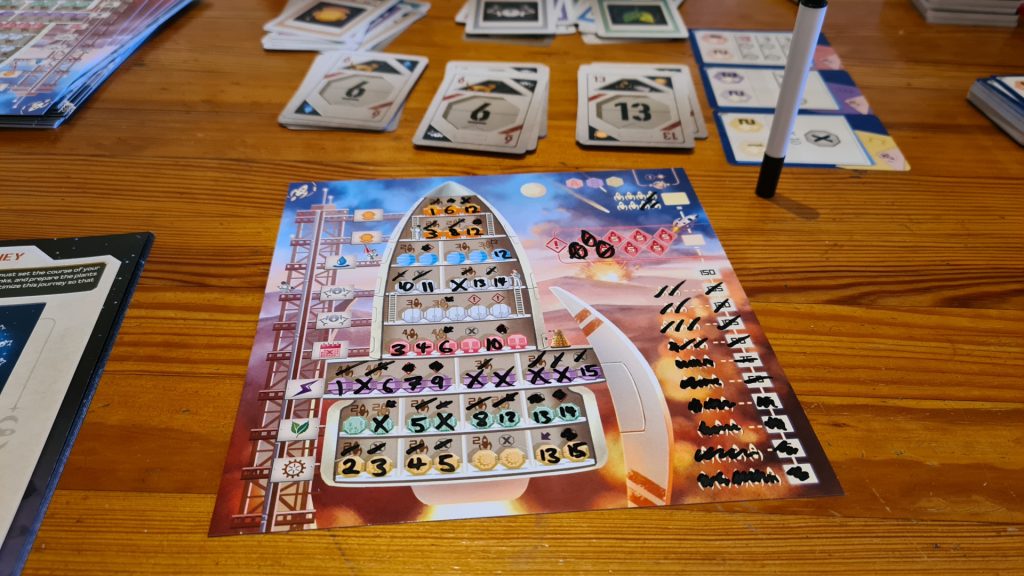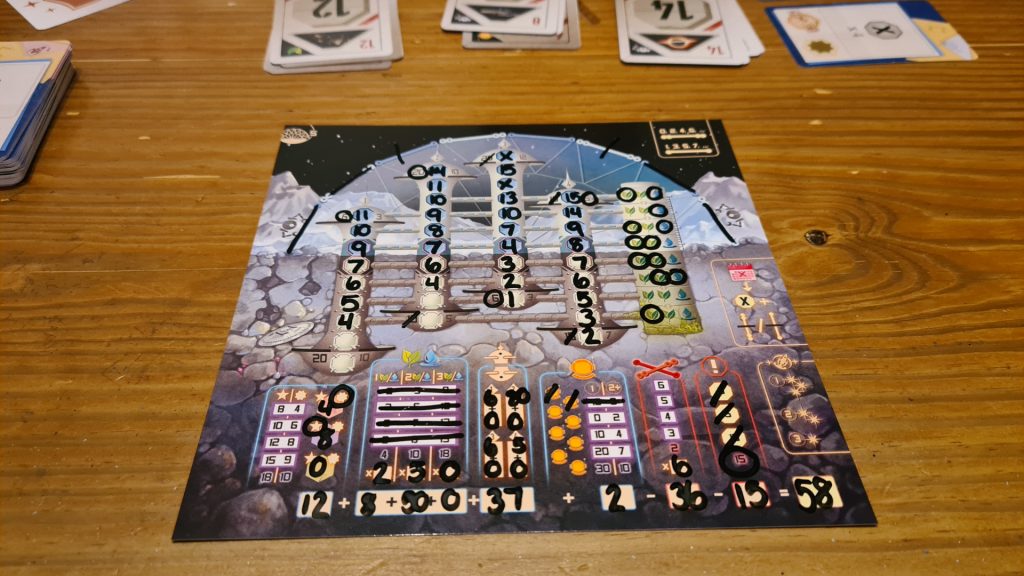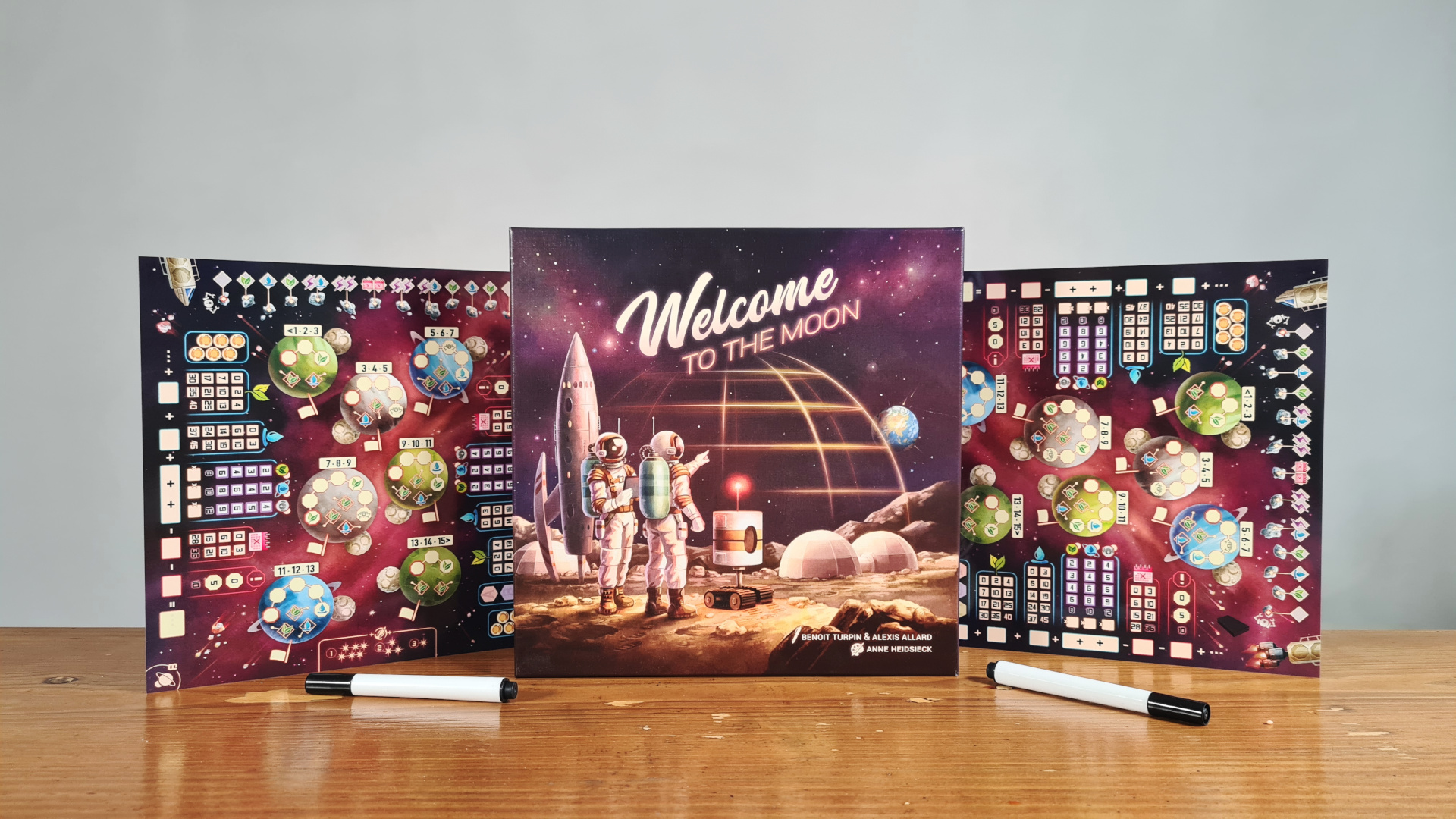Welcome to the Moon is the brand new campaign style, flip and write, board game from publisher Blue Cocker Games. Designed by Alexis Allard and Benoit Turpin, featuring artwork from Anne Heidsieck, the game sees 1 – 6 players blasting off from Earth to, you guessed it, the Moon! In an effort to save humanity players will, over the course of 8 games, blast off, land, mine and more. However, will this want to make you save humanity or does the experience not really take off? Let’s find out!
Akin to the original Welcome To, this game sees each player slowly filling out score sheets with numbers in ascending order. In Welcome To The Moon the maps written on might change but there are consistent rules, which are then tweaked and changed by individual maps. To start with, the deck of starship cards (the main deck) is shuffled and split into three same sized stacks. The top card of each of these stacks is flipped over so that three pairs of cards are formed. Each of the three pairs include an action from the just flipped card and a number from the card at the top of the stack. Choosing an action and number pair the player must write the number onto their scoresheet, and may trigger the action.
The astronaut action is often the most helpful, allowing the player to add or subtract up to 2 from the number it’s paired with. As numbers need to be in ascending order, this option to manipulate a number can be invaluable. When Water is taken as a pair if the number is written into a space with a water symbol you can circle it – often scoring for it at the end of the game. Plants work in a similar way but are generally attached to a section of a row, not an individual space. Planning works similar to how Bis did in the original. An X is written in any empty space – which counts as working in ascending order. The final two actions of energy and robot change the most, often activating or building different aspects outside of the numbered rows.
Whether it’s blasting off towards the moon or evacuating virus ridden quarters, each map takes these basics and adds to / adapts them. A prime example is how planning can cause a huge amount of points to be lost on mission #5: The Dome, where it splits dome sections that must be completed to not lose points. The main part of the planning action, of writing an X in a space, remains but the consequences change and makes the choice different from one mission to the next.

Three end game conditions are always in play, though specific maps may have additional end game triggers. Three objectives are put in play during setup, referring to the specific mission map. If a single player completes all three then the game ends – with points earnt for each mission players complete. If someone fills every space on their board or fails to write a number 3 times the game also ends. At this point players calculate their points to determine the winner. When playing the maps individually whoever has the most points wins. If playing the campaign the winner gets the most stars, which are accumulated across the full campaign.
Welcome To was a fairly simple, easy to get to the table, flip and write experience. Despite having a similar number of actions, and generally following the same logic of choosing a number and action combination each turn, Welcome To The Moon is certainly a step up. Individually, the missions throw additional rules into the mix, from spreading viruses, which take up room, through to numbers needing to ascend both left to right and bottom to top. At the start of each game played in the campaign players have to learn these rule changes, and while small they are that one extra step before playing.
It’s almost like owning 8 different Welcome To map packs at once, rather than one title with subtle changes from one game to the next. For variety and replayability this is phenomenal. Of course, players will have their favourite maps and these can be played time and time again outside of a full campaign. Then a campaign deck comes into play to add in new changes. To keep this review mostly spoiler free I won’t mention specifics; with these additional cards adding the likes of new objective cards or map changes into the mix.
From the get-go players will want to play through the campaign. Completely replayable, it’s more than just 8 new maps, they are chained together. Players have an option here though, the content is not locked into the campaign, allowing you to still fit a game of Welcome to the Moon into a short gap, without committing to a full 8 game experience. On this topic though Welcome To The Moon doesn’t entirely make it obvious that the first playthrough doesn’t dip into the campaign deck at all, if choosing the Introduction Campaign route.

So use the first campaign playthrough as a way to learn how to play and then jump in for another round of the full 8 games to unlock the campaign bits. This sounds like a huge amount of plays to pour into a game, without experiencing any campaign elements, and it is. There is a good amount to learn though, with each individual map having more than just facelifts. Importantly, at the end of the learning playthrough you’ll want to play more, with no campaign fatigue putting you off from going again.
The production quality of Welcome to the Moon is extremely strong. The campaign and objective decks are numbers to help flicking through them a breeze and there are boxes included to store the card types separately. With 8 unique maps to play on the box would have been huge with pads of scoresheets. Instead, wipeable game boards and drywipe pens are included, something that instantly ups the production quality of any game in the roll and write genre. It limits the game to be “only” up to 6 but who really plays 1 – 100 player flip and writes with 100 people?
While the games can be played individually this isn’t a game I’d get to the table with new players. For introducing players to the flip and write logics, the original Welcome To is that bit more relatable and simpler to teach. If players had played other roll/flip and writes then they could play without issue, but even then you wouldn’t want to jump straight into a full campaign, as any knowledge of how useful or problematic mission elements can be would be an advantage.
The sign of a good game is to want to play more. Players want to continue with the campaign, working through the 8 missions. On top of this, the fact that everyone playing wanted to instantly go again to dive into a full campaign and experience the campaign deck speaks volumes. By using wipeable boards not only is the box size reduced, it also boosts the feel and quality of the production. It comes down to the variety and amount of content in the box. I’d go as far to say that as enjoyable as some of the original Welcome To map packs are, skip them and move onto Welcome To The Moon for 8 maps in one and a thoroughly enjoyable way to play through them.
(Editor’s Note: Welcome To The Moon was provided to us by Asmodee for the review. The game is currently available from local board game stores! Find your local store here.)

